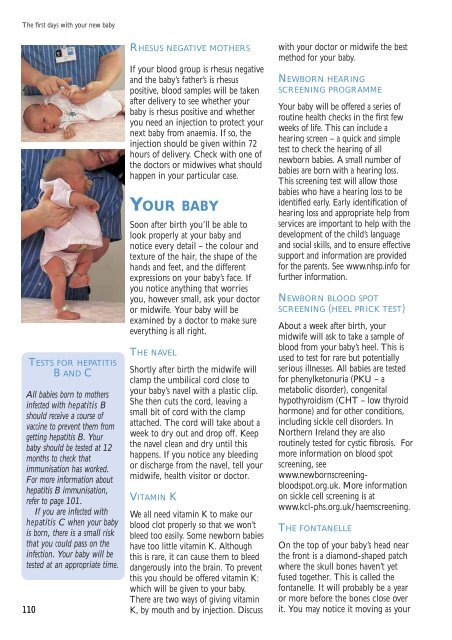here - Health Promotion Agency
here - Health Promotion Agency
here - Health Promotion Agency
Create successful ePaper yourself
Turn your PDF publications into a flip-book with our unique Google optimized e-Paper software.
The first days with your new baby<br />
TESTS FOR HEPATITIS<br />
B AND C<br />
All babies born to mothers<br />
infected with hepatitis B<br />
should receive a course of<br />
vaccine to prevent them from<br />
getting hepatitis B. Your<br />
baby should be tested at 12<br />
months to check that<br />
immunisation has worked.<br />
For more information about<br />
hepatitis B immunisation,<br />
refer to page 101.<br />
If you are infected with<br />
hepatitis C when your baby<br />
is born, t<strong>here</strong> is a small risk<br />
that you could pass on the<br />
infection. Your baby will be<br />
tested at an appropriate time.<br />
110<br />
RHESUS NEGATIVE MOTHERS<br />
If your blood group is rhesus negative<br />
and the baby’s father’s is rhesus<br />
positive, blood samples will be taken<br />
after delivery to see whether your<br />
baby is rhesus positive and whether<br />
you need an injection to protect your<br />
next baby from anaemia. If so, the<br />
injection should be given within 72<br />
hours of delivery. Check with one of<br />
the doctors or midwives what should<br />
happen in your particular case.<br />
YOUR BABY<br />
Soon after birth you’ll be able to<br />
look properly at your baby and<br />
notice every detail – the colour and<br />
texture of the hair, the shape of the<br />
hands and feet, and the different<br />
expressions on your baby’s face. If<br />
you notice anything that worries<br />
you, however small, ask your doctor<br />
or midwife. Your baby will be<br />
examined by a doctor to make sure<br />
everything is all right.<br />
THE NAVEL<br />
Shortly after birth the midwife will<br />
clamp the umbilical cord close to<br />
your baby’s navel with a plastic clip.<br />
She then cuts the cord, leaving a<br />
small bit of cord with the clamp<br />
attached. The cord will take about a<br />
week to dry out and drop off. Keep<br />
the navel clean and dry until this<br />
happens. If you notice any bleeding<br />
or discharge from the navel, tell your<br />
midwife, health visitor or doctor.<br />
VITAMIN K<br />
We all need vitamin K to make our<br />
blood clot properly so that we won’t<br />
bleed too easily. Some newborn babies<br />
have too little vitamin K. Although<br />
this is rare, it can cause them to bleed<br />
dangerously into the brain. To prevent<br />
this you should be offered vitamin K:<br />
which will be given to your baby.<br />
T<strong>here</strong> are two ways of giving vitamin<br />
K, by mouth and by injection. Discuss<br />
with your doctor or midwife the best<br />
method for your baby.<br />
NEWBORN HEARING<br />
SCREENING PROGRAMME<br />
Your baby will be offered a series of<br />
routine health checks in the first few<br />
weeks of life. This can include a<br />
hearing screen – a quick and simple<br />
test to check the hearing of all<br />
newborn babies. A small number of<br />
babies are born with a hearing loss.<br />
This screening test will allow those<br />
babies who have a hearing loss to be<br />
identified early. Early identification of<br />
hearing loss and appropriate help from<br />
services are important to help with the<br />
development of the child’s language<br />
and social skills, and to ensure effective<br />
support and information are provided<br />
for the parents. See www.nhsp.info for<br />
further information.<br />
NEWBORN BLOOD SPOT<br />
SCREENING (HEEL PRICK TEST)<br />
About a week after birth, your<br />
midwife will ask to take a sample of<br />
blood from your baby’s heel. This is<br />
used to test for rare but potentially<br />
serious illnesses. All babies are tested<br />
for phenylketonuria (PKU – a<br />
metabolic disorder), congenital<br />
hypothyroidism (CHT – low thyroid<br />
hormone) and for other conditions,<br />
including sickle cell disorders. In<br />
Northern Ireland they are also<br />
routinely tested for cystic fibrosis. For<br />
more information on blood spot<br />
screening, see<br />
www.newbornscreeningbloodspot.org.uk.<br />
More information<br />
on sickle cell screening is at<br />
www.kcl-phs.org.uk/haemscreening.<br />
THE FONTANELLE<br />
On the top of your baby’s head near<br />
the front is a diamond-shaped patch<br />
w<strong>here</strong> the skull bones haven’t yet<br />
fused together. This is called the<br />
fontanelle. It will probably be a year<br />
or more before the bones close over<br />
it. You may notice it moving as your

















